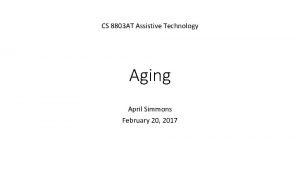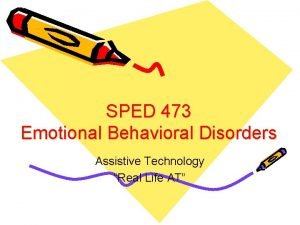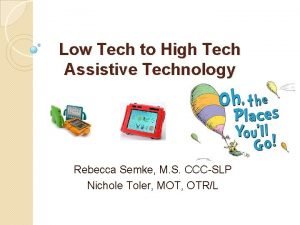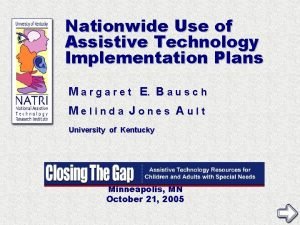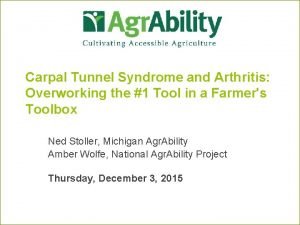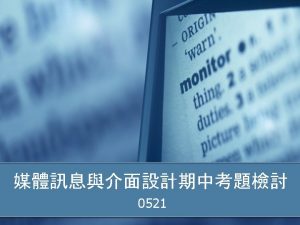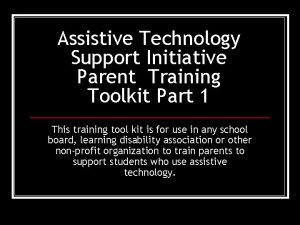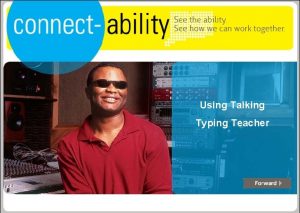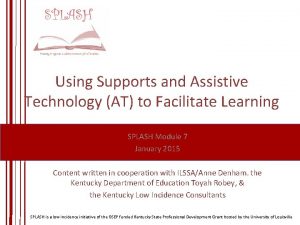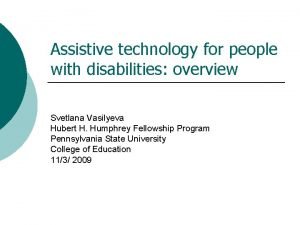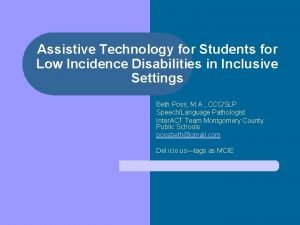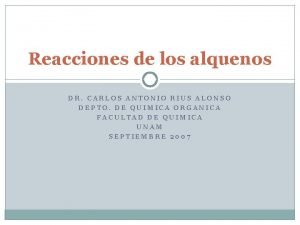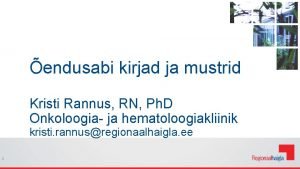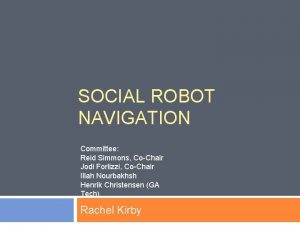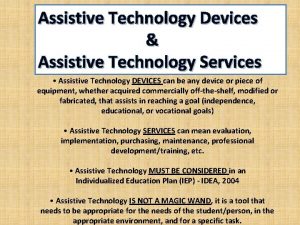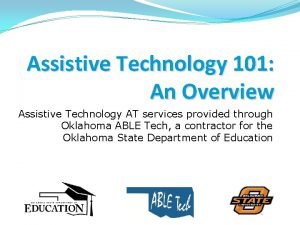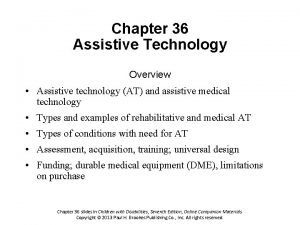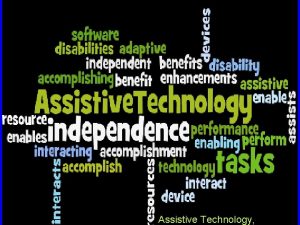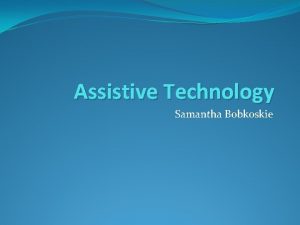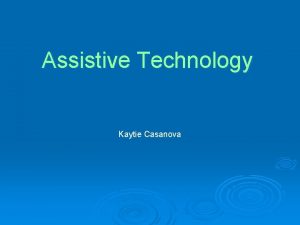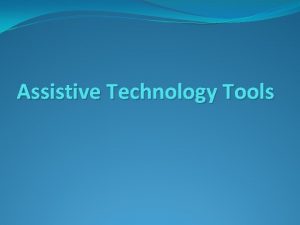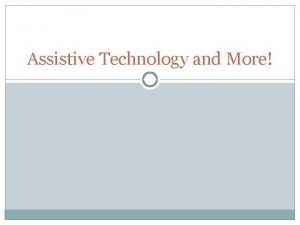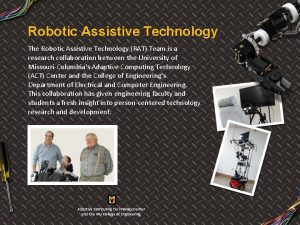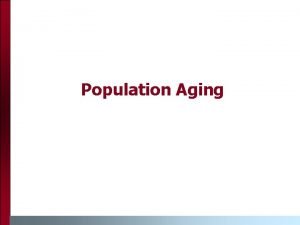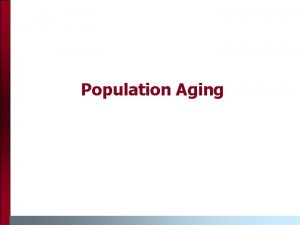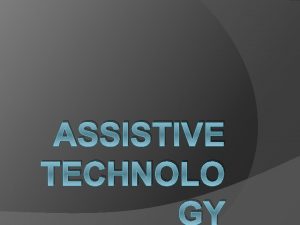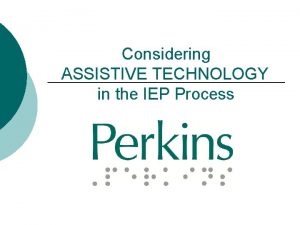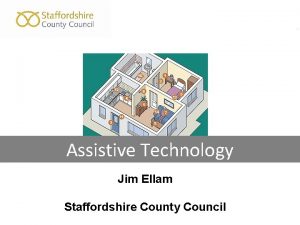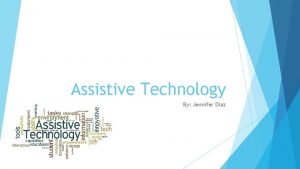CS 8803 AT Assistive Technology Aging April Simmons


























- Slides: 26

CS 8803 AT Assistive Technology Aging April Simmons February 20, 2017

Outline • Definition • Causes • Physiological Effects • Personal, Familial & Social Effects • AT Use & Acceptance

Definition: Stages of Life 0 -2 years: Infancy 2 -12 years: Childhood 13 -18 years: Adolescence 18 -25 years: Young Adulthood 25 -40 years: Adulthood 40 -60 years: Middle Age 60+ Old Age 60 -65 Later Adulthood 65 -74 Young-old 75 -84 Middle-old 85+ Old-old

Causes & Effects • Causes • Being born • Living past 60, or 65 • Why does aging cause changes in the body? • No definitive theory • Damage is a popular theory • Aging affects everyone differently • Genetics, gender, race, lifestyle, attitude • 3 Types of AT

Anatomical Changes: Effects • bone loss • results in: susceptible to fracture and osteoporosis • shrinking with age • joints become less resistant • vulnerable to injury and to arthritis • decrease in strength, size and endurance of muscle tissue • diminished skin cells • skin becomes thinner and less elastic • leads to wrinkles, bruising and tearing easier, longer to heal, more vulnerable to infection, less able to get Vitamin D from the sun

Anatomical Changes: Factors • Genetics • bad habits: smoking, drinking, sedentary lifestyle • intake of calcium and vitamin D • some medications and medical conditions • regular weight-bearing exercise • good posture • sun exposure and sunscreen use

Anatomical Changes: AT • help the elderly stay active • e. g. more recovery time, location of equipment, alternate exercises • help with painful movement • e. g. lifting chairs, walk-in tubs • help with reduced height • e. g. re-arranging cupboards

Cardiovascular Changes: Effects • increased stiffness of the chest wall • diminished blood flow through the lungs • reduction in the strength of the heartbeat • although the body compensates by pumping more blood per beat • takes longer to recover from stress, shock, surprise, exertion • artery walls slowly thicken and become less elastic • more vulnerable to normal wear and tear • buildup of plaque restricts flow of blood to the heart and brain • greater risk for stroke, heart attack, high blood pressure, kidney failure, etc. • diminished circulation • less able to regulate body temperature • more susceptible to hypothermia &heatstroke

Cardiovascular Changes: Factors • diet rich in saturated fat and cholesterol and low in fiber • sedentary lifestyle • elevated total cholesterol levels, esp. LDL • gender • stress • technological advancement of the country you live in

Cardiovascular Changes: AT • stroke detection • Samsung EDSAP (Early Detection Sensor & Algorithm Package) • BURL concepts • temperature regulation • e. g. Nest thermostat • regular reminders to drink water • e. g. high tech water bottles • healthy eating • E. g. Samsung WELT

Gastronomical Changes: Effects • chewing becomes more difficult, chew more slowly, may not chew as efficiently • esophagus doesn't contract as forcefully • wallowing larger pieces of food • takes about 50 to 100% longer to make its way to your stomach • more vulnerable to choking • some don't produce enough or any stomach acid due to gastritis • faulty vitamin B 12 absorption • anemia, irreversible nervous-system impairment, risk factor for heart disease • prone to gallstones • prone to lactose intolerance • gut/colon becomes sluggish and less toned • vulnerable to constipation • liver shrinks • handle certain medications differently • prone to ulcers • kidneys shrink

Gastronomical Changes: Factors & AT • slowing down and chewing food thoroughly • amount of fat in diet • consuming dairy products with food, or smaller amounts • drinking plenty of fluids • AT: apps for detecting lactose • e. g. Dairy Free Fast Food

Immunological Changes • decreased immunity by impairing production of antibodies • shrinking thymus gland • increase possibility of confusion in immune system • body will turn against itself and destroy its own tissues • autoimmune diseases such as rheumatoid arthritis or lupus • Factors: eating healthy, exercising, good habits • AT: help with moving around, performing (I)ADL's • • reachers orthotics replacing small switches and doorknobs rearranging the house

Metabolic Changes • muscle mass and body water decreases • basal metabolic rate (BMR) decreases • body fat increases • greater risk for heart disease, developing certain cancers, and diabetes • aggravates arthritis • Factors: • age: begins around age 25 • onset of menopause • where you store extra fat

Respiratory Changes • lungs become less elastic and chest wall stiffens • • can't cough as forcefully diminishes ability to clear germs from lungs prone to upper respiratory infections Factors: smoking • difficulties swallowing • increases the chance of aspirating particles of food into lungs • can cause pneumonia • lung function and capability drop off with time • major predictor of disease and death • Factors: regular aerobic exercise, intake of vitamin C • AT: helping with swallowing e. g. Guardian Therapy

Sensory Changes: Eyesight • weakening eyesight • decreasing ability to focus on nearby objects • tissues surrounding eyes lose their tone and fat • droopy upper eyelids and turning outward or inward of the lower lid • prone to cataracts • pupils get smaller, lenses accumulate yellow substances • prone to glaucoma which can lead to vision loss and blindness • Factors: African-Americans, family history • decreased blood flow to the retina • leads to macular degeneration • AT: glasses, contacts, surgery

Sensory Changes: Hearing Loss • hearing loss at all frequencies • reduced ability to detect changes in pitch of sounds • makes your speech less understandable • Factors: gender • walls of ear canal thin out • eardrum thickens • hair cell loss in the inner ear • Factors: nerve damage, injury, exposure to loud noise, certain medications • AT: anything that helps with hearing

Sensory Changes: Smell & Taste • lessened sense of smell • trouble savoring the flavor of food • Factors: • zinc deficiency • damage from infections • some medication • AT: (see previous discussion)

Cognitive changes • memory lapses • information processing slows • trouble multitasking • may lead to: • mild cognitive impairment (MCI) • Alzheimer's • Affected by: physical activity, healthy diet, mentally stimulating activities, social interaction, high blood pressure • AT: (see previous discussion)

Interactions with Disability • Age-acquired disability • Aging with disability

Personal, Familial & Social Effects • Personal effects • • Ability to perform ADL, IADL, EADL Independence & dignity Self-concept AT: ADL technologies, whole home technologies • Familial effects • Caregivers, role in the family • AT: aimed at caregivers, virtual visits, afterwards • Social effects • Reduced social opportunities • AT: increased mobility, virtual visits

AT Use & Adoption • • • Design SES Gender Race Culture

AT Use & Adoption - cont’d • Human Barriers • • Lack of information and knowledge Safety concerns Failing to meet perceived needs Concern of losing functional capabilities • AT Barriers • Complexity of AT • AT experienced as obstacles • Device Failure • Context Barriers • Financial Limitations • Physical Environment Limitations

Benefits of Aging • Less negativity – higher self esteem • Greater emotional stability • Clearer priorities • Wiser perspective • Better able to see big picture • Brain plasticity • Knowledge • AT needed: has fun with aging • Let’s put the “It’s On” back in ger. ONtology!

Old age is no place for sissies. -- Bette Davis Age is an issue of mind over matter. If you don't mind, it doesn't matter. -- Mark Twain or Jack Benny Old age isn't so bad when you consider the alternative. -- Maurice Chevalier Laughter is timeless. Imagination has no age. And dreams are forever. -- Walt Disney Questions?

References 1. http: //www. widener. edu/about/campus_resources/wolfgram_libr ary/documents/life_span_chart_final. pdf 2. http: //health. howstuffworks. com/wellness/agingprocess/aging. htm 3. http: //www. webmd. com/healthy-aging/features/normal-agingchanges-and-symptoms? page=43 4. http: //www. mayoclinic. org/healthy-lifestyle/healthy-aging/indepth/aging/art-20046070? pg=2
 Cs 8803
Cs 8803 Cs 8803
Cs 8803 Go talk assistive technology
Go talk assistive technology Assistive technology for behavior
Assistive technology for behavior Low tech assistive technology
Low tech assistive technology Reading untagged document with assistive technology
Reading untagged document with assistive technology Audioize
Audioize Georgia project for assistive technology
Georgia project for assistive technology National assistive technology research institute
National assistive technology research institute Assistive devices for carpal tunnel syndrome
Assistive devices for carpal tunnel syndrome Illinois assistive technology program
Illinois assistive technology program Assistive technology toys
Assistive technology toys Assistive technology wikipedia
Assistive technology wikipedia Assistive technology salary
Assistive technology salary Don johnson assistive technology
Don johnson assistive technology Talking typing teacher
Talking typing teacher Noita eye puzzle
Noita eye puzzle Meaning of assistive technology
Meaning of assistive technology Assistive technology for low incidence disabilities
Assistive technology for low incidence disabilities Gabriel simmons
Gabriel simmons Reacción de simmons–smith
Reacción de simmons–smith Shelby simmons parents
Shelby simmons parents Kristi fischer
Kristi fischer Chris simmons md
Chris simmons md Laurie simmons walking house
Laurie simmons walking house Kristi simmons
Kristi simmons Reid simmons
Reid simmons

